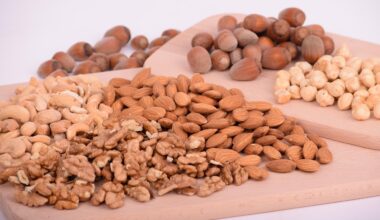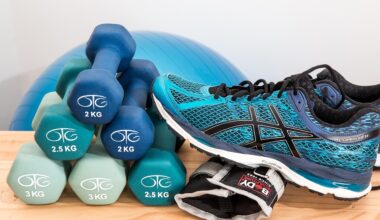Plyometrics for Speed: Drills to Boost Sprint Performance
Plyometric training is essential for athletes seeking to enhance their sprint speed, enabling explosive power and quick muscle contractions. These drills, focusing on jumping and bounding, stimulate the fast-twitch muscle fibers, crucial for acceleration during sprints. Incorporating plyometrics into your training regimen brings numerous benefits, improving both speed and agility. When practicing these exercises, emphasis should be placed on proper technique to prevent injuries and maximize effectiveness. Begin with basic drills and progress to more complex movements as strength and control improve. Effective plyometric exercises that athletes can implement include depth jumps, box jumps, and plyometric push-ups. Each of these exercises encourages stronger muscle contractions, leading to better performance metrics on the track. As you develop your plyometric strength, ensure adequate rest and recovery periods between sets to allow muscles to recover fully. This approach enables optimal output while minimizing fatigue. Always consult with a coach or fitness professional when implementing a new exercise regimen, particularly plyometric training. The insights they provide will help tailor your program to your unique fitness level and objectives, ensuring maximum benefit and safety throughout your training journey.
Benefits of Plyometric Training
Plyometric training offers athletes several benefits that go beyond just enhanced speed. By improving muscle power, these exercises help develop a stronger overall fitness foundation. Enhanced muscle elasticity through plyometrics contributes to better energy absorption and efficient force production, fostering explosive speed. This training not only helps in sprinting but also improves athletic performance in various sports such as basketball, football, and soccer. Plyometrics increases strength, agility, and coordination through its dynamic movements, making athletes more versatile. Additionally, this type of training enhances overall cardiovascular fitness by incorporating high-intensity movements, further improving endurance levels. Performing plyometric drills regularly helps condition the body to work at higher intensities, preparing the athlete for competition. The metabolic demands of conducting plyometric exercises also encourage better fat loss during training sessions. A well-structured plyometric program promotes mental toughness as athletes reap the benefits of overcoming high-energy challenges. As athletes progress, the drills can be tailored to match their growing skills and capabilities. Consequently, consistency and gradual progression in intensity will yield the best results. This strategic approach leads to notable improvements in both speed and sports performance while minimizing injury risks.
To begin plyometric training, one must establish a solid foundation in strength training. Ensuring that the body can effectively handle bodyweight movements before progressing to explosive exercises is paramount. Athletes should focus on squats, lunges, and basic strength-building exercises to create a strong base. These fundamental movements strengthen the muscles and connective tissues necessary for safe plyometric execution. Lower body strength is particularly crucial, as the legs are primarily engaged during sprinting. Additionally, core strength is vital for maintaining stability while performing explosive exercises. Athletes should dedicate time to developing and enhancing core strength with exercises like planks, Russian twists, and bridge lifts. Once the necessary strength base is established, athletes can begin incorporating plyometric exercises systematically into their training routines. Gradual progression in intensity and volume will facilitate adaptation and mitigate injury risks. Athletes should monitor their bodies closely for any discomfort or fatigue and adjust their routines accordingly. As they progress in their plyometric training, implementing various drills will keep workouts engaging and enjoyable. Importantly, incorporating rest days for recovery will afford muscles adequate time to recuperate and adapt after rigorous training.
Key Plyometric Drills for Speed
Key plyometric drills designed to boost speed include various explosive movements that maximize power and efficiency. Box jumps are excellent for developing leg strength and power, helping athletes to spring off the ground quickly. Depth jumps, where an athlete drops from a box and immediately jumps upon landing, improve reactive strength, crucial for sprinting performance. Broad jumps are effective for enhancing horizontal explosiveness, contributing to faster acceleration during sprints. Skater jumps also enhance lateral power essential for agility. Implementing single-leg variations, such as single-leg hops or bounds, further challenges athletes’ stability and muscular balance. This targeting of various muscle groups during the plyometric drills emphasizes total body performance. Each of these exercises should be performed with maximum effort to yield the best results in terms of speed enhancement. Athletes should also focus on an explosive takeoff and quick ground contact time during these drills. Proper form is essential to prevent injury, especially during complex movements. Additionally, athletes can combine these drills with sprinting sessions for a comprehensive approach to speed training. This integrated methodology ensures that athletes develop both explosive power and the necessary speed for competitive performance.
When performing plyometric drills, the importance of warm-up cannot be overstated. A thorough warm-up increases blood flow to muscles, enhancing elasticity and reducing injury risk. Dynamic stretches and mobility exercises are highly effective in preparing the body for explosive activity. Incorporating exercises such as leg swings, high knees, and lateral shuffles can serve as a valuable warm-up routine. Engaging the core and activating surrounding muscles before plyometric training helps improve overall stability and muscle efficiency. After completing a plyometric session, incorporating a cool-down routine that includes static stretching will aid in recovery and flexibility. This proactive approach helps alleviate muscle tightness and soreness, allowing for optimal performance in subsequent training sessions. Hydration is equally important, as athletes should maintain appropriate fluid levels throughout their training, especially after high-intensity workouts. Proper nutrient intake post-training aids recovery and muscle building. Athletes should focus on consuming proteins and carbohydrates to replenish energy stores. By emphasizing correct pre-and post-training practices, athletes enhance their plyometric training outcomes, leading to better sprint performance. Implementing these strategies consistently will support overall athletic development and ensure sustainable progress over time.
Conclusion and Implementation
In conclusion, incorporating plyometrics into a training regimen is a highly effective way to enhance sprint performance. The exercises promote explosive power, agility, and overall athleticism, leading to better results on the track. Athletes must approach plyometric training progressively, ensuring a solid strength foundation is established before advancing to more complex drills. The emphasis on proper techniques throughout the training regime is critical for injury prevention and achieving desired outcomes. Regular practice of a variety of plyometric movements will keep workouts stimulating and enjoyable, while also maintaining motivation. Training sessions should also include adequate rest and recovery periods, which are essential for maximizing adaptation and performance. Keeping track of progress and setting specific goals for each training phase can enhance motivation and overall effectiveness. As athletes incorporate plyometrics, monitoring their physical response is crucial to avoid strain or injury. Adjustments to training intensity may be necessary based on individual recovery capabilities. Ultimately, by prioritizing these strategies, athletes will benefit from improved speed performance through focused and effective plyometric training practices.
As athletes become proficient in their plyometric training, they may want to assess their sprinting performance and overall fitness regularly. Tracking performance through timed sprints and fitness assessments can help identify areas needing improvement, allowing athletes to adjust their routines accordingly. Additionally, working alongside a coach or trainer provides valuable insights and feedback on execution and form during plyometric drills. This collaborative approach will optimize training efficiency and effectiveness. Athletes should also consider participating in group plyometric sessions, which can enhance motivation and camaraderie among peers. Learning from others and sharing experiences leads to a more enriching training environment. Alongside plyometric training, maintaining a holistic approach encompassing strength training, speed work, and recovery will ensure comprehensive athletic development. Mixing various training modalities keeps athletes engaged while addressing different aspects of performance. Lastly, an open mind towards exploring new drills and training methodologies will foster continuous improvement and long-term success. By blending traditional training styles with innovative exercises, athletes can develop well-rounded performance skills crucial for sprinting and overall sports achievement. Embracing this journey will ultimately lead to exceptional athletic progress.



